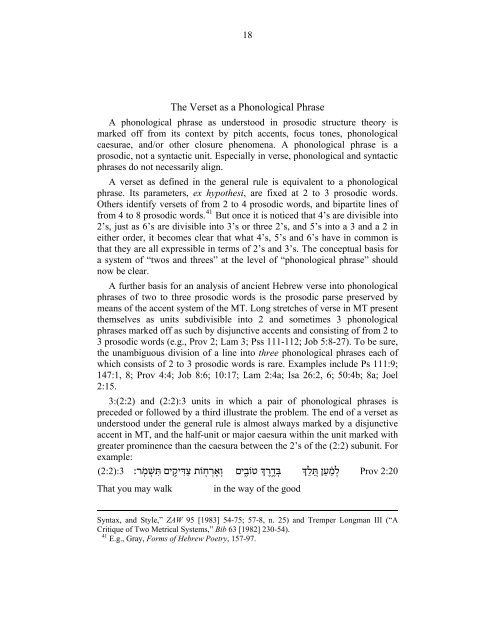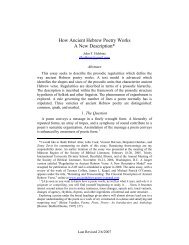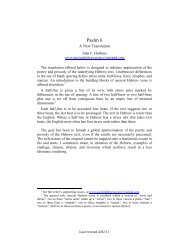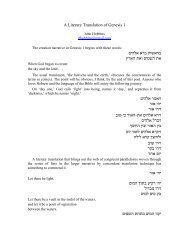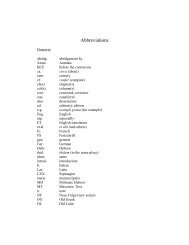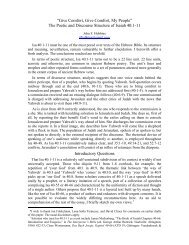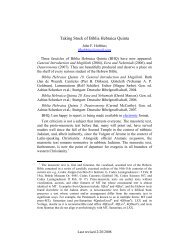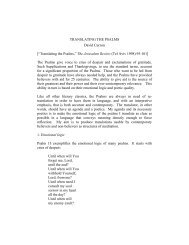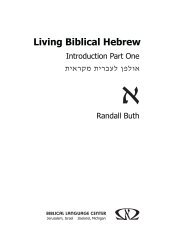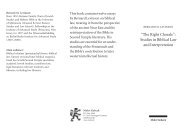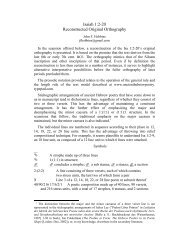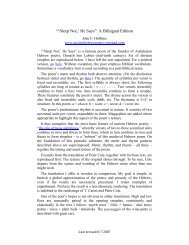Here - Ancient Hebrew Poetry - Typepad
Here - Ancient Hebrew Poetry - Typepad
Here - Ancient Hebrew Poetry - Typepad
- No tags were found...
Create successful ePaper yourself
Turn your PDF publications into a flip-book with our unique Google optimized e-Paper software.
18The Verset as a Phonological PhraseA phonological phrase as understood in prosodic structure theory ismarked off from its context by pitch accents, focus tones, phonologicalcaesurae, and/or other closure phenomena. A phonological phrase is aprosodic, not a syntactic unit. Especially in verse, phonological and syntacticphrases do not necessarily align.A verset as defined in the general rule is equivalent to a phonologicalphrase. Its parameters, ex hypothesi, are fixed at 2 to 3 prosodic words.Others identify versets of from 2 to 4 prosodic words, and bipartite lines offrom 4 to 8 prosodic words. 41 But once it is noticed that 4’s are divisible into2’s, just as 6’s are divisible into 3’s or three 2’s, and 5’s into a 3 and a 2 ineither order, it becomes clear that what 4’s, 5’s and 6’s have in common isthat they are all expressible in terms of 2’s and 3’s. The conceptual basis fora system of “twos and threes” at the level of “phonological phrase” shouldnow be clear.A further basis for an analysis of ancient <strong>Hebrew</strong> verse into phonologicalphrases of two to three prosodic words is the prosodic parse preserved bymeans of the accent system of the MT. Long stretches of verse in MT presentthemselves as units subdivisible into 2 and sometimes 3 phonologicalphrases marked off as such by disjunctive accents and consisting of from 2 to3 prosodic words (e.g., Prov 2; Lam 3; Pss 111-112; Job 5:8-27). To be sure,the unambiguous division of a line into three phonological phrases each ofwhich consists of 2 to 3 prosodic words is rare. Examples include Ps 111:9;147:1, 8; Prov 4:4; Job 8:6; 10:17; Lam 2:4a; Isa 26:2, 6; 50:4b; 8a; Joel2:15.3:(2:2) and (2:2):3 units in which a pair of phonological phrases ispreceded or followed by a third illustrate the problem. The end of a verset asunderstood under the general rule is almost always marked by a disjunctiveaccent in MT, and the half-unit or major caesura within the unit marked withgreater prominence than the caesura between the 2’s of the (2:2) subunit. Forexample:(2:2):3לְ ֗ מַ עַ ן תֵּ֭ לֵ ְךבְּ דֶ ֣רֶ ְך טוֹבִ ֑ יםוְ אָ רְ ֖חוֹת צַ דִּ י קִ ֣ים תִּ שְׁ ֽמֹר׃That you may walkin the way of the goodProv 2:20Syntax, and Style,” ZAW 95 [1983] 54-75; 57-8, n. 25) and Tremper Longman III (“ACritique of Two Metrical Systems,” Bib 63 [1982] 230-54).41 E.g., Gray, Forms of <strong>Hebrew</strong> <strong>Poetry</strong>, 157-97.


